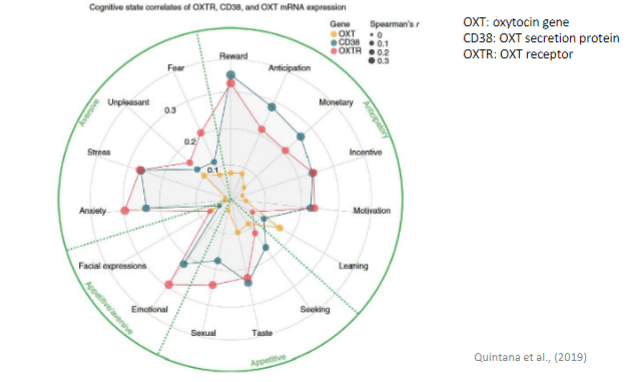affiliative and reproductive behaviour
1/35
There's no tags or description
Looks like no tags are added yet.
Name | Mastery | Learn | Test | Matching | Spaced |
|---|
No study sessions yet.
36 Terms
describe the experimental wedding
oxytocin (love hormone) levels went up
vasopressin (possession hormone) went down in Nic
cortisol (stress hormone) was up in Linda before and after the ceremony but went down in Nic after the ceremony
testosterone levels doubled in Nic
castration and hormone replacement
testis transplantation restores normal development in roosters
transplanted testis were not not connected to blood supply or neuronal networks
their effect was mediated by chemicals released to the blood stream
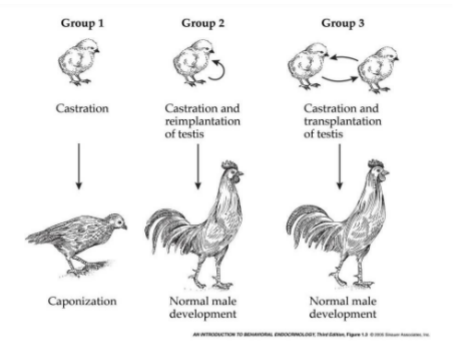
describe Brinkley’s surgeries
testis transplant from farm animals to humans with ‘weak sexuality’
they were successful for some time but ethical, methodological and safety aspects made this unsustainable
what is a hormone?
signalling molecule that can carry messages to distant targets through the blood stream
what is a neurohormone?
a hormone released by neurons; targets neighbouring or distant cells
what is a target?
an organ/cells that can detect hormone(s) and it is affected by it
what are the classes of hormones?
steroid hormones - derived from cholesterol; can travel across cell membranes
amine hormones - derived from amino acid tyrosine; cannot cross the cell membrane
peptide and protein hormones - amino acid chains; cannot cross cell membrane; activate membrane receptors
where are hormones produced?
sex hormones - females: ovaries for oestrogen and progesterone; male: testes for testosterone
growth hormone (GH) - pituitary gland
thyroxine (TH) - thyroid gland
insulin - pancreas
adrenaline (ADH) - adrenal gland
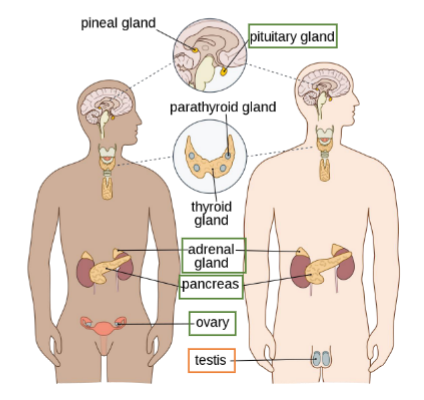
what determines genetic sex?
depends on the sex chromosome carried by the sperm and egg (ovum) that generates them
depends on the father sperm cells which carry X or Y sex chromosomes
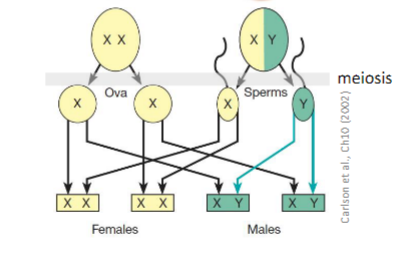
development of sex organs
all the info to develop bodies of either sex is present in the 22 non-sex and the x chromosomes
exposure to sex hormones (before and after birth) is responsible for sexual dimorphism
the Y chromosome controls the development of the glands that produce the male sex hormone
what are the sex organs?
gonads (ovaries and testes)
internal sex organs
external genitalia
key characteristics of gonads
first to develop - produce ova or sperm and hormones
sex-determining region Y (SRY) gene (from Y chromosome) express SRY protein that differentiates gonads into testes
lack of SRY results in ovaries development
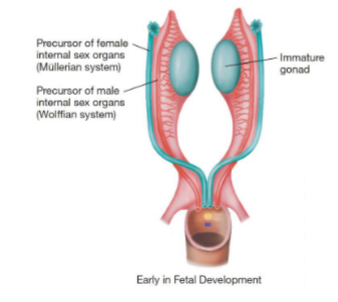
key characteristics of internal sex organs
during first two months of gestation, foetus can develop into either male or female
at month 3, if testes are present and producing hormones, internal sex organs develop into male ones
female internal organs do not need presence of any other hormone to develop
key characteristics of external genitalia
do not need hormonal influence to develop into female organs
dihydrotestosterone (androgen produced by testes) develops external genitalia into male version
sexual maturation
secondary sex characteristics develop during puberty and are also influenced by hormones
hypothalamus release gonadotropin-releasing hormones which stimulates hormone release by testes or ovaries
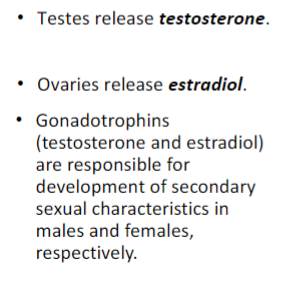
hormonal control of sexual behaviour
hormones control sexual development but also interact indirectly with the nervous system to affect sexual behaviour (e.g. menstrual cycle)
in non-primate females, sexual behaviour is linked to ovulation; primate females can mate at any time during their menstrual cycle
hormones and sexual behaviour in male rodents
male rodents’ sexual behaviour - mounts, intromission, ejaculation
depends on testosterone levels - castrated male rats injected with testosterone reinstate sexual behaviour
hormones and sexual behaviour in female rodents
female rodents’ sexual behaviour - lordosis
female initiates copulation; when receptive, the male will approach
sexual behaviour depends on oestradiol and progesterone
neural control of sexual behaviour: tools
retro-tracing to define the circuit that control sexual organs
activation of Fos in key brain regions
identify neurons containing sex hormone receptors
neural control of sexual behaviour: males
spinal mechanism - men with complete spinal cord transection above 10th thoracic segment can ejaculate
a group of neurons in the lumbar region (spinal ejaculation generator) lumbar spinothalamic (Lst) cells control ejaculation
destruction of Lst cells in rats abolishes ejaculation without affecting mounts or intromissions
brain mechanisms excite or inhibit spinal circuits
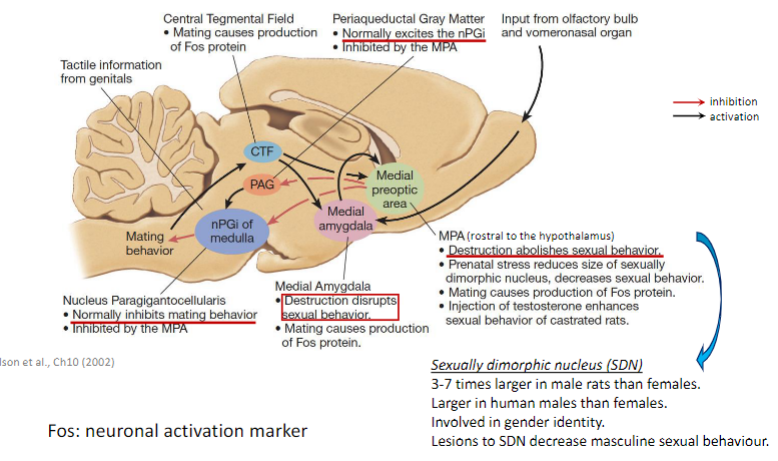
neural control of sexual behaviour: females
do not have a spinal circuit controlling sexual behaviour
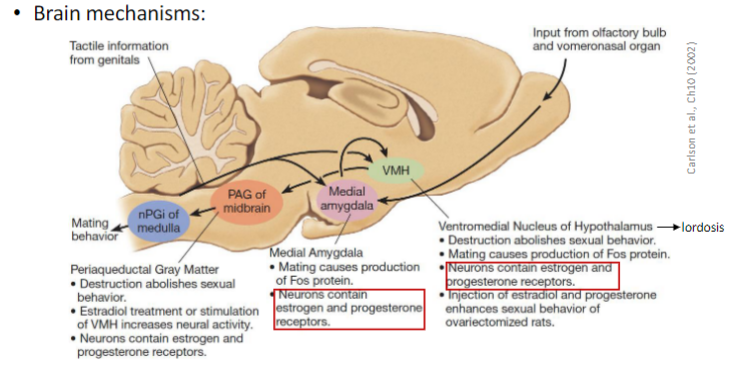
describe parental behaviour in mammals
most mammalian species show parental behaviour
hormonal and neuronal control mostly base on data from rodents
most research on maternal behaviour

describe maternal behaviour in rodents
birth assistance by pulling the pups gently
nursing
periodically licks pups’ anogenital region to stimulate urination and defecation
pups retrieval if they leave or are removed from the nest
behaviour influenced by prenatal hormones but passage of pups through the birth canal also helps
hormones can influence behaviour but does not control it
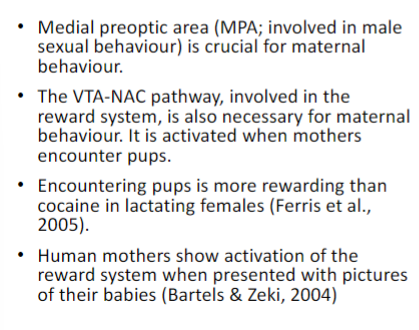
describe paternal behaviour in voles
few mammalian species show paternal care for the offspring
monogamous prairie voles share offspring care; polygamous male meadow voles leave female after mating
size of MPA is less sexually dimorphic in prairie voles than meadow voles
MPA lesions disrupt paternal behaviour in rats and prairie voles; MPA is also involved in paternal behaviour
what are affiliative behaviours?
positive social behaviours within the same or different species
can involve individuals of the same or different sex (formation of pair bonds in voles; prosocial behaviours in humans)
the neuropeptides oxytocin and vasopressin are key for complex social behaviours

pair bonding in mammals
only 3-5% of mammals are monogamous
biparental species - males and females raise the young
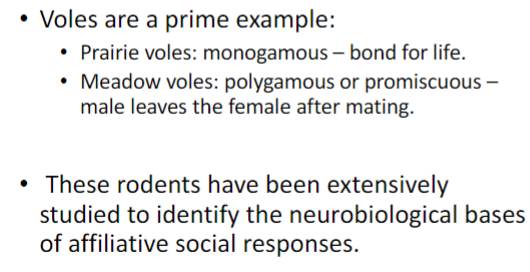
hormones influencing pair bonding
exposure to a partner while injected with VP or OXT increased preference for partner
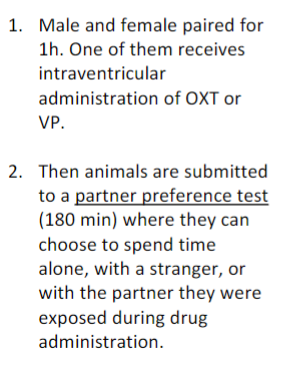
neurobiology of pair bonds
associated with the density of VP receptors in the reward areas of the brain
after mating and cohabitating with a female, male prairie voles tended to spend significantly more time in contact with their partner than the stranger
overexpression of vasopressin receptor in ventral pallidum enhanced mate preference in meadow voles
how is oxytocin involved in pair bonding?
OXT receptors are highly expressed in PFC and Nacc in prairie voles
partner preference in prairie voles is disrupted after blocking OXT or VP receptors
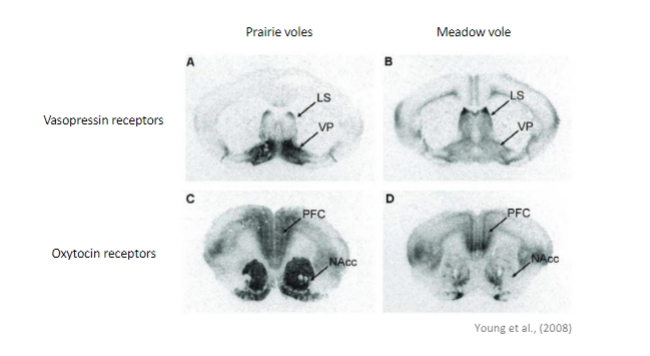
formation of pair bonds in humans
oxytocin and vasopressin seem to influence pair bonding in humans
OXT intra-nasal caused relaxation and anxiety reduction in humans
maternal and romantic love activated regions of the brain rich in vasopressin and oxytocin receptors
role of oxytocin in prosocial behaviour
administration of oxytocin has subtle effects in social behaviours in humans: trust, empathy, social approach, altruism
oxytocin has effects on brain regions related to reward and fear related processing
growing interest in translating oxytocin administration for the treatment of psychiatric conditions
effects on behaviour are highly influences by individual and contextual conditions
how does oxytocin effect trust?
subjects given oxytocin show significantly higher MU transfer levels
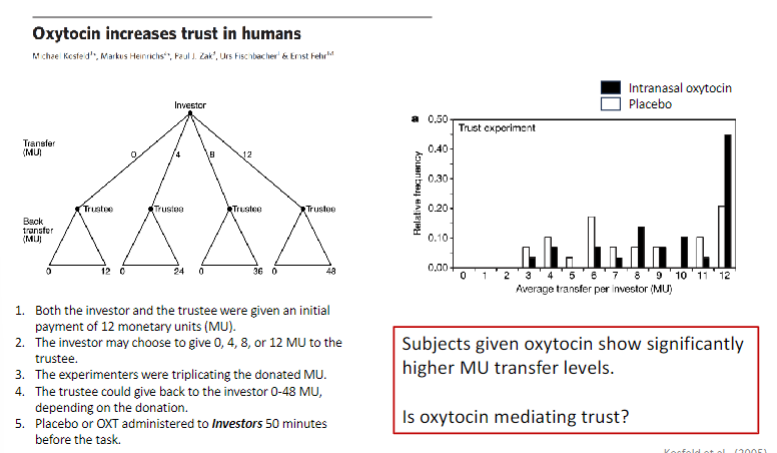
how does oxytocin effect altruism?
positive correlation between OXT levels and social donation
no effect in the ecological frame
OXT increased donations in the social frame but decreased those in the ecological frame
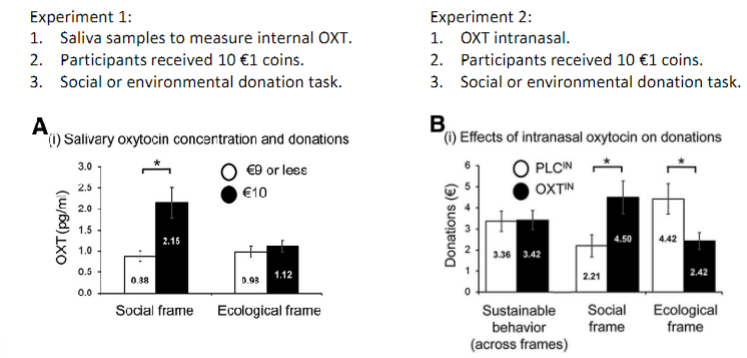
how does oxytocin effect empathy?
OXT administration increased empathy ratings in all dimensions
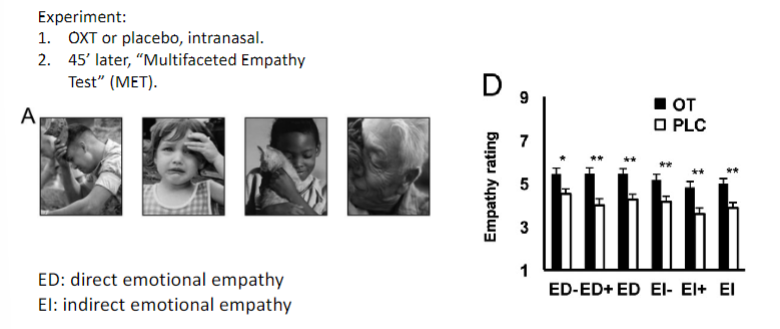
how does oxytocin effect social approach?
OXT administration decreased the social distance that female participants kept between themselves and an unfamiliar (and attractive) male experimenter
role of oxytocin in prosocial behaviour
expression of OXT and OXT receptors maps into areas involved in anticipatory, appetitive, and aversive cognitive states
